The neck yoke, which appears later in the archaeological record than the dorsal yoke, was a unique harness system which was concentrated in the northern Gaul region between the Rhine and Seine. It has been thoroughly discussed and analyzed by Professor Georges Raepsaet1 using the funerary monuments in the region. These same funerary monuments were also examined by Lefebvre des Noëttes. His examination of these monuments led him to confuse and eventually combine the dorsal and neck yokes into one harness system2.
This neck yoke basically consisted of a metal piece placed on a thick pad which was fastened with straps and sat midway on the equid's neck3. The shafts or the center pole was affixed to the neck yoke (see Fig. 12). What is especially interesting is the unique construction of the shafts and center pole which contain a characteristic bend towards these front of the shaft at about the shoulder level of the horse5.
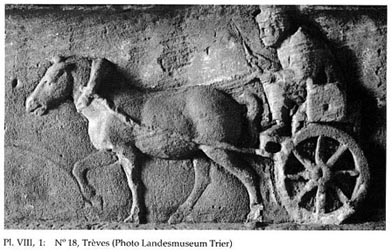
Fig. 12: Position of Neck Yoke4
This unique bend in the shafts is to be seen wherever the Gallo-Roman neck yoke was used. It was essential to promote the correct traction as will be described later in this section. Some have considered the neck yoke to be a sort of proto-collar, the pre-cursor of the modern horse collar, but Professor Raepsaet does not believe this to be the case7.
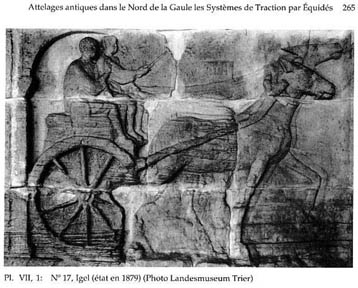
Fig. 13: Igel Monument showing bend in shafts6.
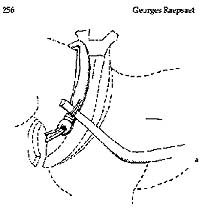
Fig. 13: Position of Neck Yoke vs Modern Collar 8

Fig. 14: Modern Horse Collar9
It is easy to see when comparing the two positions in Figure 13 and a modern collar shown in Fig. 14 how easy it would be to believe that the Gallo Roman Neck yoke could be easily turned into the Medieval horsecollar as a result of lowering the attachment point. No experiments such as those performed by J. Spruytte with the dorsal yoke have ever been conducted with the Gallo-Rhine neck yoke, but Professor Raepsaet after consulting with various specialists has concluded that the traction is shoulder traction10. An essential part of this harness system is the unique sharp curvature at the end of the shafts11 which Abeele has pointed out helps maintain the line of traction12.
Ultimately the real question is how did this unique type of harness function? Professor Raepsaet raised the possibility that this might represent a step towards shoulder traction. How can this be, one might ask. The hypothesis put forward using a cisium13 is that if weight and pressure is placed on the front end of the cart , this would then cause the pressure on the neck to be as low as possible. This would then remove any possibility of pressure on the windpipe, thus bringing about an early form of shoulder traction14. A unique find at Neupotz has yielded the metal remnants of the Gallo-Roman neck yoke. (See Fig.15). The accompanying article also supports Professor Raepsaet' contention that the yoke was a form of shoulder traction15.

Fig. 15: Metal Neck Yoke pieces from Neupotz16
Although this harness system is concentrated in the small geographic area of North Gaul, metal neck yoke pieces similar to those found at Neupotz have been found in scattered locations throughout the area of the Roman Empire (See Fig 16). However it the area of North Gaul which has received the most scholarly
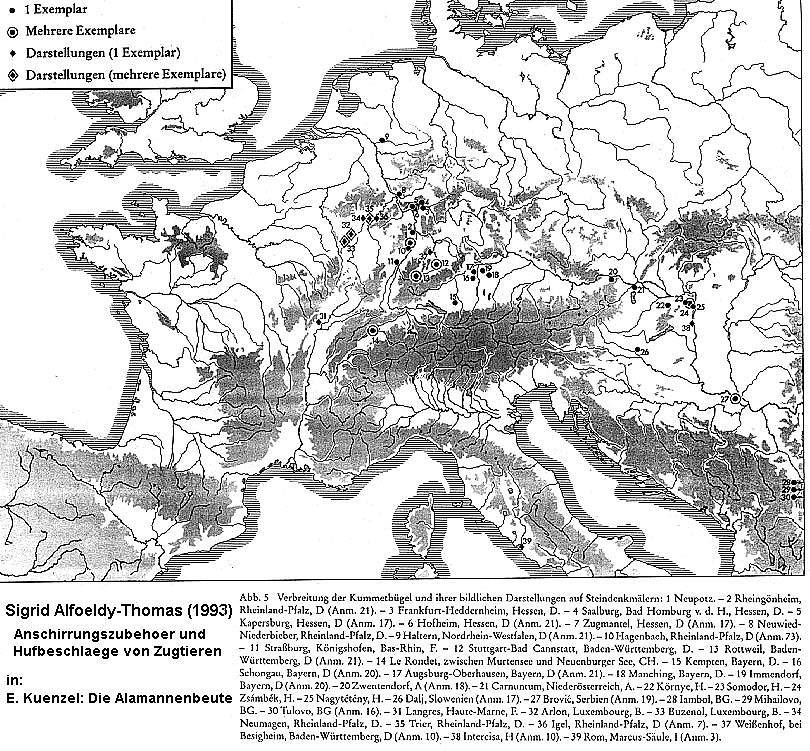
Fig. 16: Geographical Locations of Metal Neck Yoke finds17
attention thanks to Professor Georges Raepsaet. He has consistently maintained that the neck yoke played an important part in the economy of the area, where there was a large amount of economic activity in this area which was conducted via land transport. This area knew remarkable prosperity in the 2nd and 3rd Centuries AD due to the commercialization of agricultural resources and products made by a variety of regional and local craftsmen. Based on the evidence of the funerary monuments of the regions, wheeled transport drawn by equids played a large role in this activity and flourished for several centuries17.
In summary we find that at every point, the archaeological evidence proves Lefebvre des Noëttes wrong, such as when the Commandant makes the statement that this harness system (or rather the one he believed existed) prevented the horse from lowering his head. He boldly asserts that the raised head of the horse is found in ALL documents, yet the monuments of Neumagen and Langres give the lie to this statement since they show equids pulling wagons with their heads lowered.
But since the harness is only one aspect of a traction system, I now want to turn to the roads over which these various harness systems were employed.

Fig. 17: Relief from Neumagen18
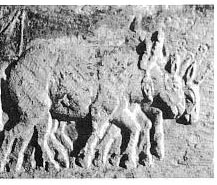
Fig. 18. Relief from Langres19
- See various articles by Georges Raepsaet. Professor Raepsaet has spent many years making an extensive study of this unique Gallo-Roman Harness.
- See Figure 1
- Raepsaet, 1982. p. 241
- Ibid., Pl. VIII, No. 8.
- Ibid., p. 236
- Ibid., Pl. VII
- Raepsaet, Brancards et Transport, p. 32
- Raepsaet, 1982, p. 256
- Ibid., p. 273
- Raepsaet, Brancards et Transport, p. 53
- Raepsaet, 1982, pp. 236-239
- Abeele, pp. 20-23
- Roman light 2-wheeled cart
- Rapaset, Brancards et Transport, p. 53
- Alfoeldy-Thomas, pp.351-354
- Ibid.
- Ibid.
- Raepsaet, 1982, 246-47.
- Ibid., Pl. IX.
- Ibid., Pl. XIII, p. 271